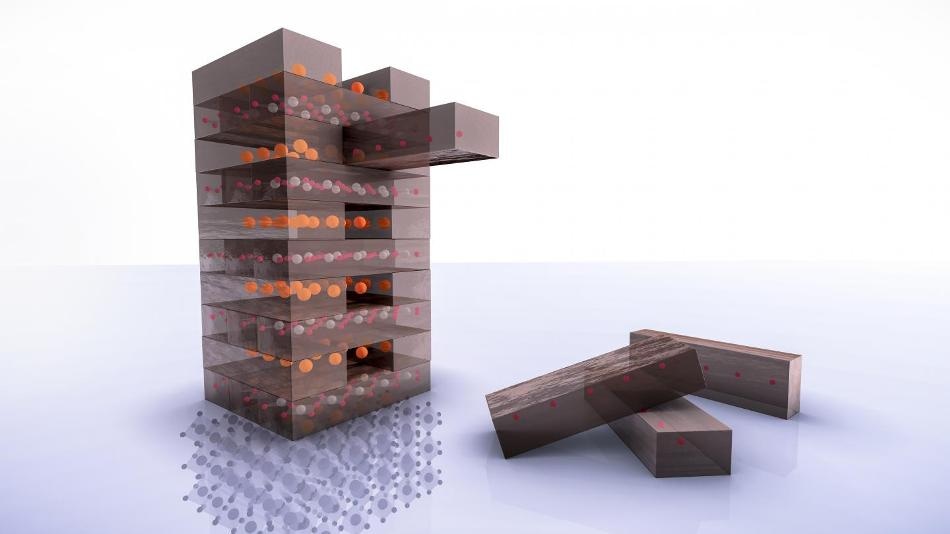Aug 30 2019
The first-ever nickel oxide material has been developed by researchers from the Department of Energy’s SLAC National Accelerator Laboratory and Stanford University. This material exhibits evident signs of superconductivity—the potential to transmit electrical current with zero loss.
 An illustration depicts a key step in creating a new type of superconducting material: Much like pulling blocks from a tower in a Jenga game, scientists used chemistry to neatly remove a layer of oxygen atoms. This flipped the material into a new atomic structure—a nickelate—that can conduct electricity with 100% efficiency. (Image credit: Greg Stewart/SLAC National Accelerator Laboratory)
An illustration depicts a key step in creating a new type of superconducting material: Much like pulling blocks from a tower in a Jenga game, scientists used chemistry to neatly remove a layer of oxygen atoms. This flipped the material into a new atomic structure—a nickelate—that can conduct electricity with 100% efficiency. (Image credit: Greg Stewart/SLAC National Accelerator Laboratory)
The material is also called a nickelate and is the first of a prospective new class of unconventional superconductors quite similar to the copper oxides, or cuprates. In 1986, the discovery of cuprates increased hopes that superconductors could eventually function at close to room temperature and revolutionize power transmission, electronic devices, and other technologies.
Due to the similarities, researchers are wondering whether nickelates could also superconduct at comparatively high temperatures. Meanwhile, the new material appears to be different from the cuprates in basic ways—for example, it may not possess a kind of magnetism possessed by all the superconducting cuprates.
This could annul leading theories of the way these unconventional superconductors operate. After over 30 years of research, no one has figured it out. The experiments were guided by Danfeng Li, a postdoctoral researcher with the Stanford Institute for Materials and Energy Sciences at SLAC, and published in Nature on August 28th, 2019.
“This is a very important discovery that requires us to rethink the details of the electronic structure and possible mechanisms of superconductivity in these materials,” stated George Sawatzky, a professor of physics and chemistry at the University of British Columbia who was not involved in the research but wrote a commentary accompanying the paper in Nature.
Sawatzky continued, “This is going to cause an awful lot of people to jump into investigating this new class of materials, and all sorts of experimental and theoretical work will be done.”
A Difficult Path
Since the discovery of cuprate superconductors, researchers have aimed at developing similar oxide materials based on nickel, which is placed immediately adjacent to copper on the periodic table of the elements.
However, developing nickelates that have an atomic structure conducive to superconductivity was found to be astonishingly challenging.
As far as we know, the nickelate we were trying to make is not stable at the very high temperatures—about 600 degrees Celsius—where these materials are normally grown. So we needed to start out with something we can stably grow at high temperatures and then transform it at lower temperatures into the form we wanted.
Danfeng Li, Postdoctoral Researcher, Stanford Institute for Materials and Energy Sciences, SLAC
Starting with a perovskite—a material characterized by its exclusive, double-pyramid atomic structure—that included nickel, neodymium, and oxygen, he doped the perovskite by incorporating strontium. This is a regular process that involves adding chemicals to a material to induce more of its electrons to flow freely.
This removed electrons from the nickel atoms, making vacant “holes,” and the nickel atoms did not feel good about it, stated Li. Thus, the material became unstable, rendering the subsequent step—developing a thin film of it on a surface—extremely difficult; it took him six months to make it work.
“Jenga Chemistry”
As soon as this was performed, Li cut the film into small pieces, which were then loosely wrapped in aluminum foil and sealed in a test tube with a chemical that carefully removed a layer of its oxygen atoms—quite similar to removing a stick from a shaky tower of Jenga blocks. This changed the atomic structure of the film into a completely new one—a strontium-doped nickelate.
“Each of these steps had been demonstrated before,” stated Li, “but not in this combination.”
He recollected the precise moment in the lab, around 2 a.m., when tests showed that the doped nickelate could be superconducting. Li was so thrilled that he was awake all night. In the morning, he co-opted the usual meeting of his research team to reveal them what he had discovered. Shortly, several members of the research group joined him in a round-the-clock attempt to enhance and analyze this material.
Further investigations would unravel that the nickelate was, in fact, superconducting in the temperature range of 9–15 K—extremely cold, but a first start, with probabilities of higher temperatures ahead.
More Work Ahead
Studies on the new material are in a “very, very early stage, and there’s a lot of work ahead,” warned Harold Hwang, a SIMES investigator, professor at SLAC and Stanford and senior author of the report. “We have just seen the first basic experiments, and now we need to do the whole battery of investigations that are still going on with cuprates.”
According to Hwang, besides other things, researchers will prefer to dope the nickelate material in different ways to check how this influences its superconductivity over a range of temperatures, as well as find whether other nickelates can turn superconducting. Other research works will investigate the magnetic structure of the material and its relation to superconductivity.